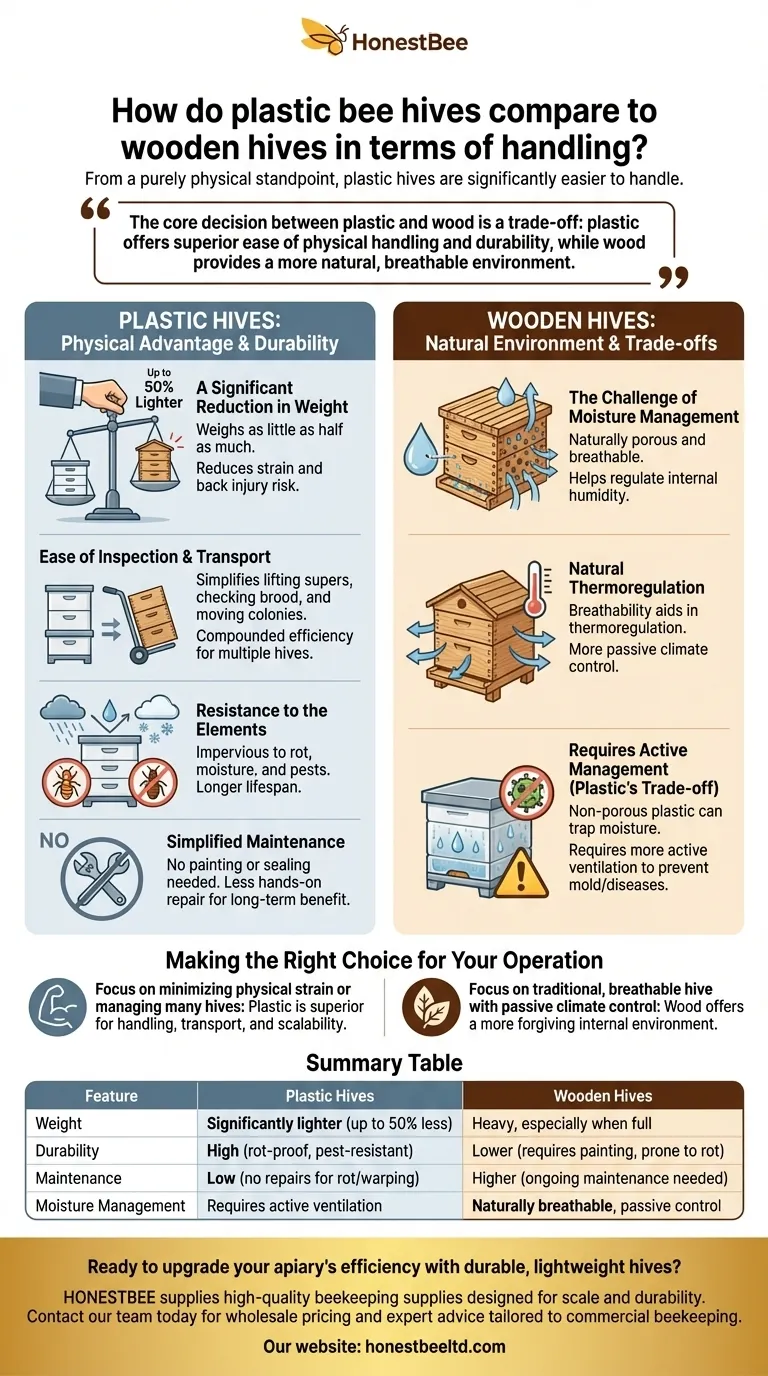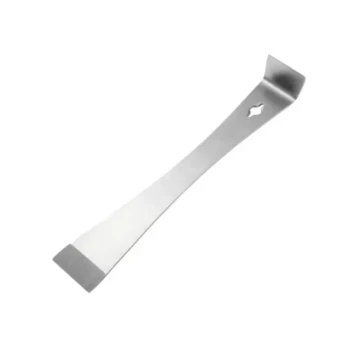From a purely physical standpoint, plastic bee hives are significantly easier to handle than their wooden counterparts. Their lighter weight dramatically reduces the strain of lifting hive bodies and moving colonies, a clear advantage for beekeepers of all scales.
The core decision between plastic and wood is a trade-off: plastic offers superior ease of physical handling and durability, while wood provides a more natural, breathable environment that can be more forgiving in terms of moisture management.

The Physical Advantage: Weight and Mobility
The most immediate and noticeable difference when handling plastic hives is the reduction in weight. This has a cascading effect on nearly every physical task in the apiary.
A Significant Reduction in Weight
Plastic hives can weigh as little as half as much as a wooden hive of the same configuration. A standard wooden deep box filled with frames, honey, and bees can be a significant physical challenge to lift.
Reducing that weight by half makes a substantial difference in beekeeper fatigue and the risk of back injury over a season.
Ease of Inspection and Transport
This weight advantage simplifies routine management. Lifting supers for inspections, checking brood boxes, and moving hives to new locations for pollination or forage becomes a much more manageable task.
For beekeepers with multiple colonies, this efficiency gain is compounded, saving considerable time and energy.
Durability and Long-Term Handling
Beyond initial lifting, the material properties of plastic affect how a hive is handled over its entire lifespan.
Resistance to the Elements
Plastic is impervious to rot and moisture. It does not degrade from rain, snow, or ground contact, giving it a much longer potential lifespan with less maintenance.
Wooden hives, by contrast, require painting or sealing to protect them from the elements and are susceptible to rot and pest damage over time.
Simplified Maintenance
This durability means plastic requires less hands-on repair. You will not spend time fixing rotten corners, replacing warped components, or dealing with termites. This is a long-term handling benefit that reduces the overall workload.
Understanding the Trade-offs
The benefits of plastic's light weight and durability do not come without compromises. These trade-offs directly impact how you must manage, or "handle," the colony's health.
The Challenge of Moisture Management
Wood is naturally porous and breathable, allowing it to absorb and release moisture, which helps regulate the hive's internal humidity.
Plastic is non-porous and can trap moisture. This condensation can lead to mold growth and may create an environment favorable to diseases like Nosema if not properly ventilated. This requires more active management from the beekeeper.
Natural Thermoregulation
The breathability of wood also aids in thermoregulation. While modern plastic hives have good insulating properties, they do not manage the internal climate as passively as wood does.
Beekeepers using plastic may need to pay closer attention to providing adequate ventilation in both hot and cold weather to ensure the colony's well-being.
Making the Right Choice for Your Operation
Choosing between plastic and wood depends on balancing the physical demands of beekeeping with the environmental needs of the bees.
- If your primary focus is minimizing physical strain or managing many hives: Plastic's light weight and low maintenance make it the superior choice for handling, transport, and scalability.
- If your primary focus is a traditional, breathable hive that aids in passive climate control: Wood's natural properties offer a more forgiving internal environment that requires less intervention for moisture management.
Ultimately, understanding these material differences empowers you to choose the hive that best aligns with your physical capabilities and beekeeping philosophy.
Summary Table:
| Feature | Plastic Hives | Wooden Hives |
|---|---|---|
| Weight | Significantly lighter (up to 50% less) | Heavy, especially when full |
| Durability | High (rot-proof, pest-resistant) | Lower (requires painting, prone to rot) |
| Maintenance | Low (no repairs for rot/warping) | Higher (ongoing maintenance needed) |
| Moisture Management | Requires active ventilation | Naturally breathable, passive control |
Ready to upgrade your apiary's efficiency with durable, lightweight hives?
For commercial apiaries and distributors, managing dozens or hundreds of hives is a major logistical challenge. The physical strain of heavy wooden equipment can slow down inspections and transport, impacting your bottom line.
HONESTBEE supplies high-quality beekeeping supplies and equipment designed for scale and durability. Our wholesale-focused operations provide the reliable, efficient equipment you need to reduce beekeeper fatigue and streamline your operations.
Let's discuss how our hive solutions can benefit your business. Contact our team today for wholesale pricing and expert advice tailored to commercial beekeeping.
Visual Guide

Related Products
- Plastic Bee Hive Stand for Beekeeping
- Professional Insulated Plastic Bee Hives
- Langstroth Bee Hives Bee Keeping Box for Beginners Beekeeping
- HONESTBEE Professional Long Handled Hive Tool with Precision Cutting Blade
- 7 x Auto Bee Flow Hive Frames Plastic Beekeeping Hive Box Supplies
People Also Ask
- Why is it important to level a hive stand properly? Prevent Catastrophic Failure & Ensure Hive Health
- How do bees regulate the temperature of their hive during the summer? Discover Their Natural Cooling System
- How does the longevity of plastic bee hives compare to wooden hives? Discover the Durable Choice
- What is the purpose of a hive stand in a Langstroth hive? Protect Your Hive and Boost Colony Health
- How do bees regulate ventilation and temperature in the hive? Master Hive Climate Control



















